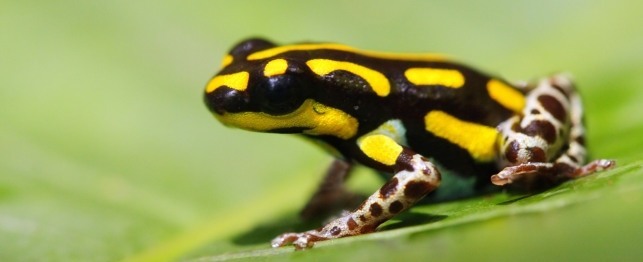

Reptiles
Poison dart frogs (Dendrobatidae) are beautiful, tiny creatures that secrete a dangerous toxin through their skin. When kept in captivity and fed the bland diets available to us, none of these frogs retain skin toxicity for more than a few weeks. But don't tempt fate. Handling these frogs is not recommended, for their safety if not for yours. They should be considered lovely to look at but off limits to hold.
If their terrarium is kept clean and tiny insects are readily available for food these frogs are moderately easy to keep. They are considered a species for moderately advanced hobbyists. Only those looking for a long commitment need apply: The record captive life span for the green and black poison frog is in excess of 20 years!
The dendrobatids are small to tiny frogs. The largest species of this family is less than 3 inches in length, the smallest barely an inch long. These frogs move rapidly in erratic little hops, and despite the gaudy colors of many, can be surprisingly difficult to see and follow in the rainforest undergrowth.
The green and black poison frog is one of the best understood of the genus, and is now bred extensively by hobbyists. Besides its typical green and black coloration, brilliant blue and black and coppery-brown and black color morphs are also known. A native of Central America, this species has long been established in Hawaii.
The poison frogs are adapted to life in tropical rainforests. The females are slightly the larger sex. Captive-bred poison frogs now supply the majority of the pet trade. Those available are usually in the one third to one half grown size range.
Typically both the hatchlings and the adults of this beautiful, diminutive frog are brightly colored in metallic green and ebony. Some may be blue-green and black, and some specimens from Panama have the green entirely replaced by bright blue. This species is adult at a slender 1.5 inches svl (snout-vent length). Males are less robust, slightly smaller, and sit a little more erect than the females. Expanded toepads help these little frogs ascend into low vegetation.
These frogs are secretive, and even where abundant, may be difficult to find. They require a moist microhabitat. They are adept at evading observation, darting beneath the closest fallen leaf when disturbed. Males often sit and chorus from atop logs or vegetation. The calls are insect-like tweets and peeps.
If many visual barriers are present in the terrarium, these frogs can be kept communally. To assert dominance males grapple (wrestle) with each other. Adult females also are hierarchical. The preferred temperature range for the terrarium is a humid 78 to 85 degrees Fahrenheit.
The diet of the green and black poison frog in the wild consists of a wide variety of tiny insects and arthropods. Ants of various species seem a preferred prey. Captives eat pinhead crickets, termites, springtails, fruit flies and aphids. The crickets and fruit flies are commercially available. The other insects must be gleaned from nature.
Fast growing baby poison frogs need considerable dietary calcium. Dust the baby crickets with vitamin-mineral supplements at least once weekly.
For their size, poison frogs eat a great amount. Food should always be available. Terrarium freshness is the key to good health and long life for these frogs.
Handling can be described by one word: Don't! These tiny frogs should be considered terrarium pets of the "no-hands-on" variety. This is not because of the possible danger to you from their skin secretions, but because of the danger to them from your own skin secretions. If you must handle your poison frog, wash and thoroughly rinse your hands both before and after. Their permeable skin will absorb any impurities from your hands, and the residue of many items that humans occasionally have on their skin (soaps, perfumes, cleaning agents, insecticides) can be injurious or fatal to your frog.
These are active frogs, but they are not prodigious leapers. They should be given a minimum of a 15-gallon rainforest terrarium for a trio or two pairs. The tank should have a substrate of damp unmilled sphagnum moss (or a carpet of green woodland moss) and contain vining plants (such as "pothos" for beauty, visual barriers, and to help retain a high relative humidity). Provide your frogs with several tiny hideboxes and a petri dish or two of fresh water. Many poison frog breeders use halved coconut shells as hideboxes. Maintain the terrarium temperature at 78 to 85 F. Full-spectrum (UV producing) lighting will be necessary to keep the plants alive and a glass cover over all except where the light is sitting will retain a high humidity. The tank should be gently misted once or twice a day, but don't allow a water buildup in the substrate.
Copyright © 2005-2016 Pet Information All Rights Reserved
Contact us: www162date@outlook.com